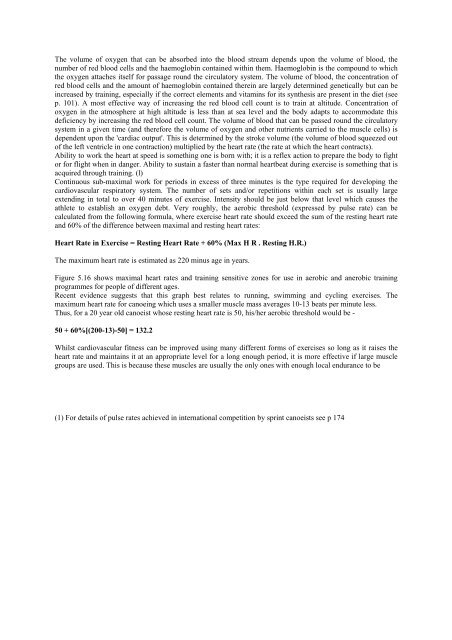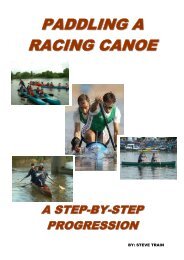The Science of Canoeing By Richard Cox
The Science of Canoeing By Richard Cox
The Science of Canoeing By Richard Cox
You also want an ePaper? Increase the reach of your titles
YUMPU automatically turns print PDFs into web optimized ePapers that Google loves.
<strong>The</strong> volume <strong>of</strong> oxygen that can be absorbed into the blood stream depends upon the volume <strong>of</strong> blood, the<br />
number <strong>of</strong> red blood cells and the haemoglobin contained within them. Haemoglobin is the compound to which<br />
the oxygen attaches itself for passage round the circulatory system. <strong>The</strong> volume <strong>of</strong> blood, the concentration <strong>of</strong><br />
red blood cells and the amount <strong>of</strong> haemoglobin contained therein are largely determined genetically but can be<br />
increased by training, especially if the correct elements and vitamins for its synthesis are present in the diet (see<br />
p. 101). A most effective way <strong>of</strong> increasing the red blood cell count is to train at altitude. Concentration <strong>of</strong><br />
oxygen in the atmosphere at high altitude is less than at sea level and the body adapts to accommodate this<br />
deficiency by increasing the red blood cell count. <strong>The</strong> volume <strong>of</strong> blood that can be passed round the circulatory<br />
system in a given time (and therefore the volume <strong>of</strong> oxygen and other nutrients carried to the muscle cells) is<br />
dependent upon the 'cardiac output'. This is determined by the stroke volume (the volume <strong>of</strong> blood squeezed out<br />
<strong>of</strong> the left ventricle in one contraction) multiplied by the heart rate (the rate at which the heart contracts).<br />
Ability to work the heart at speed is something one is born with; it is a reflex action to prepare the body to fight<br />
or for flight when in danger. Ability to sustain a faster than normal heartbeat during exercise is something that is<br />
acquired through training. (l)<br />
Continuous sub-maximal work for periods in excess <strong>of</strong> three minutes is the type required for developing the<br />
cardiovascular respiratory system. <strong>The</strong> number <strong>of</strong> sets and/or repetitions within each set is usually large<br />
extending in total to over 40 minutes <strong>of</strong> exercise. Intensity should be just below that level which causes the<br />
athlete to establish an oxygen debt. Very roughly, the aerobic threshold (expressed by pulse rate) can be<br />
calculated from the following formula, where exercise heart rate should exceed the sum <strong>of</strong> the resting heart rate<br />
and 60% <strong>of</strong> the difference between maximal and resting heart rates:<br />
Heart Rate in Exercise = Resting Heart Rate + 60% (Max H R . Resting H.R.)<br />
<strong>The</strong> maximum heart rate is estimated as 220 minus age in years.<br />
Figure 5.16 shows maximal heart rates and training sensitive zones for use in aerobic and anerobic training<br />
programmes for people <strong>of</strong> different ages.<br />
Recent evidence suggests that this graph best relates to running, swimming and cycling exercises. <strong>The</strong><br />
maximum heart rate for canoeing which uses a smaller muscle mass averages 10-13 beats per minute less.<br />
Thus, for a 20 year old canoeist whose resting heart rate is 50, his/her aerobic threshold would be -<br />
50 + 60%[(200-13)-50] = 132.2<br />
Whilst cardiovascular fitness can be improved using many different forms <strong>of</strong> exercises so long as it raises the<br />
heart rate and maintains it at an appropriate level for a long enough period, it is more effective if large muscle<br />
groups are used. This is because these muscles are usually the only ones with enough local endurance to be<br />
(1) For details <strong>of</strong> pulse rates achieved in international competition by sprint canoeists see p 174



